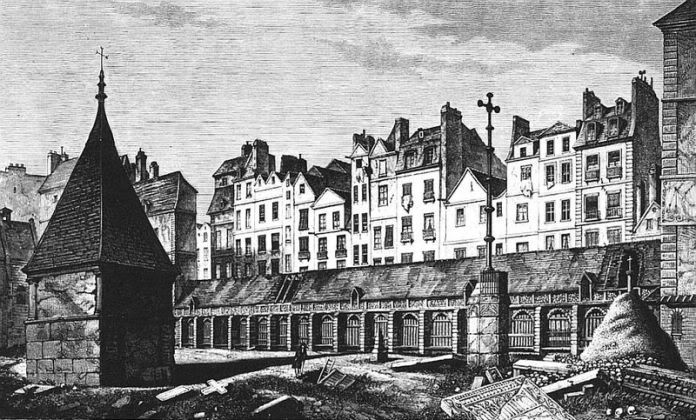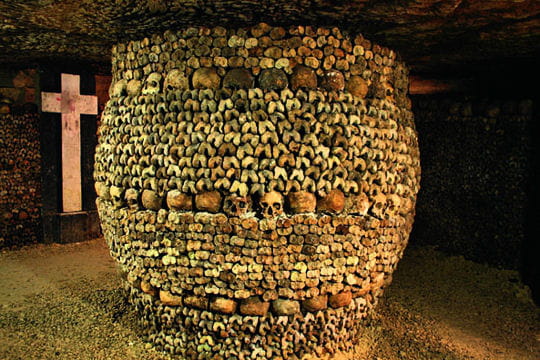Under the streets of Paris, there lies a city of the dead. Long stone passages, damp with underground water, curve endlessly beneath the twinkling city of light and love, paying homage to a time when living until 30 was a lifetime, and it was quite possible to meet the Angel of Death around a dark corner some rainy night.
 |
| The unassuming outside entrance Source |
Before the construction of the Paris Catacombs, Parisians were buried in cemeteries on the outskirts of the city with only a few families buried in graveyards near churches. However, as Christianity came into the area, a growing demand rose from families with relatives buried in these far-flung cemeteries to have their loved ones moved to the consecrated grounds under and around the churches of the city. As demand grew, more and more people began burying their relatives in small consecrated church cemeteries, until there was no room for new bodies to be put in the hallowed ground. In an attempt to remedy the overcrowding situation, churches began to open mass graves, often where the bones of people who were too poor to pay for a funeral service would be buried along with other paupers.
 |
| Saints Innocents Source |
In the early 12th century, a mass consecrated burial ground was opened near the Saints Innnocents church and slowly filled to the breaking point. By the 17th century, the sanitary conditions surrounding Saints Innocents were atrocious. Residues resulting from the decaying organic matter entered directly into the earth, contaminating Paris' water supply with lime, a chemical that was often used to treat bodies.
 |
| Source |
Burials in Saint Innocents continued however; even though the graveyard was full, it was still an extremely sought after place for burials, as well as being one of the main sources of revenue for the church, so the clergy continued to fill the graveyard until all four sides were lined with charniers: places to put the exhumed bones to make room for new bodies to be buried. It was a man by the name of Alexandre Lenoir, Paris' Police Lieutenant General who had the idea to use empty underground tunnels on the outskirts of the city in order to create a new place where the dead might rest, and the exhumation of Paris' dead to the catacombs began in 1786.
| Crypt of the Sepulchral Lamp Source |
Volunteers loaded tipcarts with bones draped in black cloth, and a horse drawn parade of the dead began its slow winding way to the catacombs, lead by a crowd of chanting priests. At first, the bones were simply heaped in the new catacomb along with crosses, urns, and other religious paraphernalia. In 1810, Louis-Etienne Hericart de Thur, Lenoir's successor, began directing the workers to arrange the bones in the famous walls they still resemble today, both in an attempt to save space and to pay respect to the dead.
| Bones from the former Magdeleine Cemetery Source |
He also set tombstones and cemetery decorations, (those that had not sunk into the muck along with the thousands of bodies from earlier cemeteries) around the walls and near the bones, where they still stand, proclaiming their messages of remembrance. Today the catacombs are open to visitors. A narrow stone staircase leads into the darkness, alongside a hidden aquaduct which directs underground springs away from the vaults as best it can. After passing through a winding hallway of mortared stone, guests will find themselves confronted with a foreboding message:
 |
| Stop! This is the Empire of the Dead. Source |
Beyond is the city of bones, walls upon walls, passages lined with skulls and femurs, many arrangements artistic in nature.
 |
| Skull heart Source |
 |
| Skull "keg" Source |
The path winds on through the catacombs, and often splits off into the darkness. These ways are barred by gates to keep the living from wandering off into parts of the catacombs that cannot be navigated...paths of the dead from which they might never return.
 |
| Source |



If I'm ever in Paris, I'm for sure checking this out!!
ReplyDeleteI hope you do, and make sure to take lots of pictures!
ReplyDelete